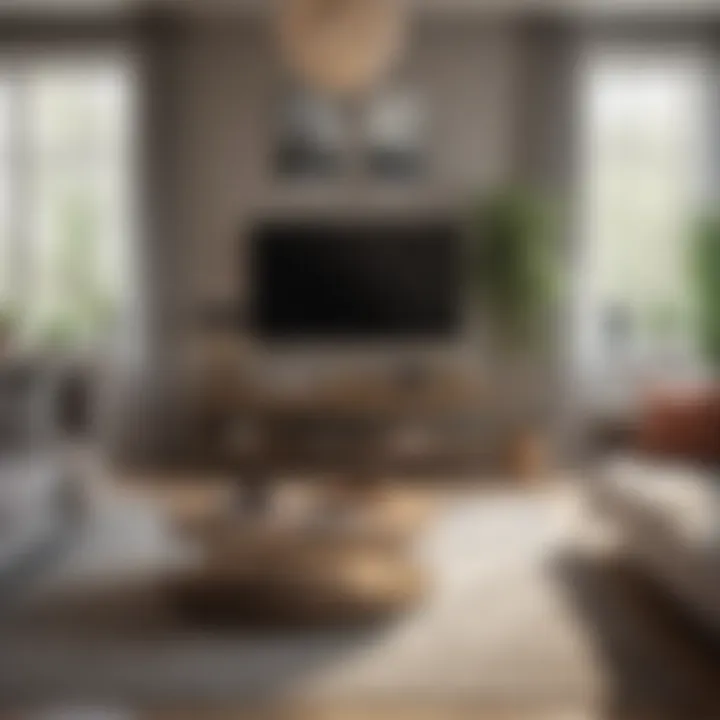Selecting the Perfect Coffee Table: Size Matters


Intro
Selecting a coffee table is not merely about aesthetics; it encompasses a careful consideration of space, function, and style. The right coffee table can enhance a living area, making it more visually appealing and functional. Conversely, the wrong size can create clutter or bare spaces, undermining the overall design vision. This article delves into how to effectively choose a coffee table by focusing specifically on size, ensuring that both homeowners and design enthusiasts make informed decisions.
Interior Design Tips
Appropriate Dimensions
When considering a coffee table, the first aspect to evaluate is size. An ideal coffee table should align with the surrounding furniture dimensions, optimizing both comfort and visual appeal. The general rule is to leave a gap of about 18 inches between the coffee table and the seating. This spacing allows for ease of movement and functionality, accommodating drinks and decor without obstructing room flow.
Trendy Design Ideas
Many contemporary coffee table styles are expanding beyond traditional dimensions. For example, low-profile tables fit well with sectionals, bringing balance and proportion to a room. Rectangle shapes remain common but round tables have seen resurgence as they ease circulation in tight spaces while softening hard lines.
Color Schemes and Combinations
The color of the coffee table directly affects the room's cohesion. Light-colored tables can brighten up dark spaces, whereas dark woods may offer warmth and richness. Consider how colors interact within the context of existing furnishings. Coordinated palettes create harmony, while contrasting shades can make a bold statement.
Furniture Arrangement Techniques
Arranging your coffee table within your furniture layout is essential. It serves as a functional center piece and often dictates arrangement flow. Placing a table subtly in a defined zone, such as in front of a sofa, promotes conversation while ensuring accessibility for both relaxation and entertainment.
Entertaining Essentials
For many, the coffee table is the heart of entertaining. Careful thought for function greatly enhances the hosting experience. A modestly sized, well-chosen table can function as a mini-hub for casual gatherings or festive displays.
Table Setting Inspiration
When entertaining, aim for simplicity and elegance on your table. Utilize decorative trays for organization, along with vibrant flowers or candles, to create an inviting look. Use varied heights within your decor to create depth and interest.
Menu Planning Tips
Consider what kinds of gatherings you typically host. Finger foods are practical, requiring minimal space. Make sure the surface is clear enough for guests to comfortably place their plates and drinks. A laid-out spread should consider easy movement without isolating conversations.
Party Theme Suggestions
Tailoring your table decor to match specific party themes maximizes the engaging feel of your space. From a casual movie night with popcorn to an elegant evening featuring cocktails, thoughtful embellishing of the coffee table sets the tone effectively.
A coffee table serves not only as a functional element but also as a contributor to the ambiance of your space.
Epilogue
Selecting the size of a coffee table is crucial in shaping both functionality and visual aesthetics within any room. By following these guidelines, one can find the perfect coffee table that balances design vision with practical needs. A carefully chosen coffee table enhances a living space, making it more inviting for relaxation and entertaining.
Understanding Coffee Table Sizes
Choosing the right coffee table size plays a pivotal role in achieving harmonious interior design. It is not merely about aesthetics; it intertwines functionality, usability, and space dynamics. Understanding coffee table sizes allows homeowners and design enthusiasts to select tables that perfectly align with their living spaces.
Knowing standard dimensions is essential when selecting a coffee table, especially since too small or too large pieces can mishmash a room's layout. A well-chosen coffee table not only serves its purpose but enhances other furnishings in the area, creating an effective design scheme. Embracing the significance of size when choosing a coffee table ensures your living environment resonates with both comfort and elegance.
Standard Coffee Table Dimensions
Standard coffee tables typically range in length from 36 to 52 inches, with heights between 16 and 18 inches, and depths spanning 18 to 30 inches. These dimensions are designed to accommodate most living room settings. However, it is crucial to assess existing furniture heights, as the table should complement the proportions of sofas and chairs.
Another critical factor is the table's intended use. If entertaining is a regular occurrence, a larger surface area may provide the necessary space for drinks, snacks, and decor. Therefore, a table's size should fit your lifestyle needs as much as the room conditions.
How Size Affects Usability
The usability of a coffee table largely depends on its size. When it is too big, it can obstruct pathways; conversely, a size that is too small may lead to overcrowding of space due to its inadequate functionality. Maintaining appropriate distances between the table and surrounding furniture promotes readability and comfort.
An optimal space between 14 to 18 inches between the coffee table and surrounding seating allows for easy movement without crowding the space.


Functionality also involves considering family activities. An ideal coffee table accommodates various functions — whether it be dining, playing games, or placing decorative items. Thus, not only the measurements but also the arrangement of your room must be considered.
Common Coffee Table Shapes and Sizes
Coffee tables come in various shapes: rectangular, square, round, and oval. The shape impacts the perceived size and functionality of the table within the room layout.
- Rectangular tables often suit longer couches and sectional configurations.
- Square tables function well in smaller or equally proportioned spaces.
- Round tables can enhance flow and soft edges in crowded areas, preventing sharp corners from becoming obstructions.
- Oval tables provide a compromise between rectangular and round, offering ample surface area while softening the space’s overall look.
It is vital to ensure that all selections, whether shape or size, create a sense of engagement and cohesion throughout the area. Taking time to understand these facets will result in a more deliberate and appealing design.
Measuring Your Space
Measuring your space is one of the most critical factors in choosing the right coffee table. A coffee table's functional utility and aesthetic appeal can drastically change based on its size relative to the room it's placed within. Understanding room dimensions, layout, and overall proportions ensures your table serves its purpose effectively, enhances the space visually, and maintains a harmonious indoor environment.
Room Dimensions and Layout
Considering the dimensions of the room where the coffee table will reside is vital. This includes length, width, and even height. Accurate measurements can transform how you visualize the coffee table in your space. Take into account wall placements, surrounding furniture, and the actual usable space in the room—the layout forms a structure where visual balance plays important role. A sufficient distance should remain around the coffee table, allowing for easy movement and conversation.
- A common rule suggestion is to leave approximately 18 inches between sofas and the table.
- Also, minimal escape routes need choosen around it for if emergency might arise.
"> Thoughtful layout planning prevents overcrowding while providing open and inviting spaces for those dining or entertaining."
Considering Traffic Flow
Traffic flow is not just an afterthought; it is a key consideration when measuring your space for a coffee table. You need the area around your table to be clear enough for people to walk comfortably. Walkways should never feel cramped or hinder interaction. Observe patterns in how people move through your living area. Are there main points of entry and exit? High traffic areas deserve special consideration to guide where your table sits.
- Action movements should be fluid, so a larger table in a narrow space disrupts comfort.
- Similarly, firmly anchored mini-tables might provide addtional usability without hindering movement.
Height Matters: Proportions and Visibility
Height is often overlooked but remains a major aspect of spatial dynamics. The ideal height for a coffee table is typically between 16 to 18 inches; however, height can vary based on surrounding furniture. A coffee table should ideally complement the other seating options in the room.
Your coffee table’s height can dramatically impact visibility and usability:
- Tables too low can make for awkward reaches.
- Conversely, overly tall tables complicate relaxation or sipping drinks.
Choose the right table height to ensure that guests feel comfortable while enjoying their beverages and relaxing.
In the context of your home, measuring accurately deals directly with planning and enjoyment. By learning to measure your space, at the dimensions, arrangements, and flow, selecting a coffee table becomes a more strategical process that ultimately betters your living environment.
Selecting a Coffee Table for Small Spaces
Selecting a coffee table for a small space requires thoughtful consideration of various factors. In compact living arrangements, every piece of furniture must not only serve a specific purpose but also enhance the overall aesthetics of the room. A well-chosen coffee table can maximize functionality, optimize flow, and contribute to a cohesive design. If neglected, however, selecting the wrong table could lead to a cluttered and uncomfortable environment, adversely affecting both usability and visual appeal.
Key elements to consider include size, form, versatility, and individual style preferences. By prioritizing these considerations, one can effectively navigate the constraints of small spaces without sacrificing design or comfort.
Opting for Compact Designs
When it comes to compact designs, the first step is to measure the available space and envision how the table will fit within that area. A smaller coffee table often fits seamlessly among existing furniture and avoids overwhelming the room — something larger pieces often struggle with. Chandlers or traditional oversized tables simply don’t perform well in confined areas.
Certain key dimensions make a coffee table ideal for small spaces:
- Length Total should ideally stay between 30 to 36 inches.
- Width could range from 18 to 24 inches.
- Height should generally align with surrounding seating, approximately 16 to 18 inches.
Opting for a compact table, with a streamlined silhouette, serves dual purpose. Visually light choices made of glass or slender wood can increase the openness of the area. Practically, such designs eliminate the chance for some clutter, supporting minimal maintenance too.
Multi-functional Options
Multi-functional coffee tables serve as a pivotal solution for small alcoves. Selecting a table with versatility not only elevates function but integrates seamlessly into daily routines. These tables can support diverse activities such as storage, work, or dining.
Details to consider while exploring multi-functional options include:
- Storage Compartments: coffee tables that transform to offer concealed or open storage are often beneficial to minimize jellybeans glass atop or decorative clutter.
- Lift-top Features: such designs open to reveal functional land surfaces suitable for work assignments or dining arrangements.


It is helpful to seek tables designed with hidden storage ensuring spare items are kept organized. It easily eradicates the hassle of stacked or chaotic margins too.
Leveraging Vertical Space
Making the most of vertical space can drastically alter the perception of room depth. By altering setups with coffee tables that present various vertical profiles, you can better distribute seeming visual weight across the area. Utilizing this height presents opotifmality for various usages such as centers arrangement for floral arrangements or simple literature.
When applying retention of focus through elevated elements, pay heed to:
- Grouping Smaller Items: utilizing additional accessories like smaller trays for books or ritual play connects well to optimizing square footage above coffee table spaces.
- Selecting Tall Decorative Elements: ceramics or framed art distinguish your table without borrowing earthly footprint efficient locations beneath its course form.
Designers often recommend considerate placements avoid crowding surroundings but enhance interest.
Coffee Tables in Larger Living Areas
In the context of creating a well-designed living space, coffee tables play a vital role. Especially in larger living areas, they are not merely functional items but crucial design components. Choosing the right coffee table size within this setting can enhance both usability and aesthetic appeal. A coffee table can shape movement, interaction, and comfort in the room. Its placement often anchors the entire seating arrangement. Moreover, understanding how size interacts with other elements can assist homeowners and design enthusiasts greatly.
Proportional Height and Width
Selecting a coffee table with appropriate proportions is key in larger living areas. The height of the table can affect sight lines and comfort, especially in social settings. A general guideline is that a coffee table should be about the same height as the seat of a couch. Typical heights range from 16 to 18 inches for standard sofa heights. However, in grand living spaces with oversized furniture, opting for taller models might create a more cohesive visual relationship.
In terms of width, the table should leave enough space between itself and surrounding seating. Ideally, this should be about 18 inches to allow for easy movement and conversation. Oversized or excessively narrow tables can disrupt flow and comfort. Therefore, a careful balance of these dimensions is necessary to ensure functionality while maintaining interest. Review the options and imagine how the proportions affect your layout.
Creating Distinction with Design
In larger living rooms, the coffee table can stand out as a signature piece of decor. Choosing distinctive designs can enhance the ambiance of the overall room. The material, finish, and form of the table should either complement or offer contrast to existing furniture. For example, using a glass-top table brings lightness and visual flexibility while a wooden table offers warmth and solidity. Often, accentuating the table's design involves integrating design styles—such as opting for geometric shapes or unique surface textures.
Thoughtfully selecting textures and colors can create focal points and enhance the decor narrative. It allows the coffee table to define the space while tying other elements together. Whether seamless or bold, the table design demonstrates individual style and enhances the room’s character.
It’s crucial that the coffee table does not merely replicate existing decor but engages the viewer with a dynamic interplay of style, texture, and form.
Balance and Symmetry in Larger Rooms
In larger spaces, achieving visual balance and symmetry is an essential design principle. Coffee tables can contribute to an even and harmonious appearance. Using pairs of coffee tables adds symmetry, so long as they are proportional to the room size. For example, two identical or complementary tables placed side by side can create a more inviting area. They also can foster conversation rather than a single large piece that could potentially lessen intimacy.
Additionally, it’s abjectly important to establish equilibrium with surrounding furniture. If heavy sofas occupy the room, a coffee table should be robust enough to anchor that weight visually. If light, open furniture surrounds it, choose a more delicate table to maintain airy balance. Ultimately, the interplay of these elements can result in a reflective, well-considered seating area. Reflect on what creates equilibrium in your specific living context before finalizing your coffee table choice.
Materials and Their Impact on Size Perception
Choosing the right coffee table involves more than just dimensions; the materials used greatly affect not only the perception of size, but also the overall atmosphere of a room. Varied materials embody different characteristics that can radically transform aesthetics and functionality. Understanding these factors aids in making informed decisions, fitting with personal style while accommodating space constraints.
Light vs.
Heavy Materials
The significance of material weight cannot be understated. Light materials generally create an airy feeling in an environment. Tables made of glass or certain composites belong to this category, often visually minimizing their presence. This can make a space appear more open, especially beneficial in small rooms.
In contrast, heavy materials such as solid wood or stone can create a focal point in a room. Though they may dominate the visual space, their substantiality often bestows a degree of elegance. When choosing a heavy coffee table, consider whether it complements existing design elements and doesn’t overcrowd the room's layout.
A heavier design can also imply durability, which could be a key selling point for those wanting a long-lasting piece. Additionally, mixing materials might break visual monotony; for instance, combining a solid wood base with a glass top can integrate both lightness and weight effectively.
Color and Its Influence on Size Perception
Color plays a critical role in how furniture is perceived. Lighter colors tend to enhance brightness and create an illusion of spaciousness. A white or light beige coffee table can make a room feel larger. Conversely, darker colors like navy blue or deep green generally give a sense of strength and presence to a table, which may feel intimidating in compact spaces.
When selecting a coffee table's color, take into account existing decor. A table’s hue should harmonize with wall colors and surround furnishings.
Even with designs that feature patterns, it is essential to assess how these patterns might impact the perceived size. Large, bold patterns may attract attention but also make a table seem more prominent than intended, while subtle prints can recede into the background.
Craftsmanship: Solid vs.
Hollow Structures


A coffee table's construction demonstrates how material quality influences size perception. Solid structures often appear more substantial compared to hollow designs, which may be perceived as lighter and less overpowering in a space.
Tables with solid construction bring reliability and solidity, therefore, they usually appear more durable over time. Yet, hollow structures can maintain visual softness, especially suitable for minimalist and modern settings that favor sleek lines. Hence, combining both types can create balance; a solid frame beneath a hollow top may allow one to relish stability while still appreciating visual lightness.
In summary, evaluating material choice — whether for a coffee table that engages light, showcases robust coloring, or embodies high-quality craftsmanship — significantly influences its fittingness to both design and spatial dimensions.
Design Style Considerations
Design style is a pivotal aspect to consider when choosing a coffee table by size. The design of your coffee table should harmonize with existing furniture and the overall aesthetic of the room. The interplay between various styles can define the atmosphere of a space, dictating how inviting or dynamic it feels. A well-matched coffee table can act as the founation for functionality and aesthetics in the living area, encouraging user engagement and contributing to a cohesive design theme. Additionally, understanding the nuances of style promotes effective decision-making that considers not only appearance but also practicality.
Contemporary vs.
Traditional Designs
When contrasting contemporary and traditional designs, it is important to observe their differing philosophies. Contemporary designs embrace modernity and often feature clean lines and minimal ornamentation. They tend to favor materials such as glass, metal, and sleek woods. When selecting a coffee table in these instances, size should reflect the streamlined aesthetic, emphasizing openness in the area.
On the other hand, traditional designs echo classic styles, often characterized by intricate details and rich textures. Coffee tables can be more substantial and may leverage wood carvings or glass inlays. Here, a perfect size promotes dignity to the furnishings without overwhelming the surrounding area.
Choosing the correct size shifts more than just proportions; it also influences how well the table fits into its designated style category, enhancing both aesthetics and practicality.
Industrial Styles and Size Selection
Industrial styles draw inspiration from factories or warehouses, making heavy use of raw materials like wood and metal. These tables often appear bulky or robust. This can be seen in products like reclaimed wood tables with steel frames. Size selection is vital here; a large coffee table could become a statement piece, embodying the rugged charm unique to this aesthetic.
In smaller spaces, however, seeking a table that maintains the industrial appeal yet does not dominate is crucial. Experts suggest choosing coffee tables that combine both black metal bases and wooden tops, allowing for a quality appearance without the excessive size of more ornate industrial pieces.
Minimalist Approaches and Their Implications
Minimalism values simplicity and functionality, emphasizing the ‘less is more’ principle. Consequently, when picking a coffee table in a minimalist design, size considerations become exceptionally relevant. A small table can provide necessary service without cluttering or overcrowding space. The clean lines and absence of adornments characteristic of minimalism call for precision in sizing so that a table feels integral rather than dispensable.
Elements like open space underneath the table become a fundamental aspect in design and usability. Funnels of air around furniture formulate a sleek feel, making sure that size aligns perfectly with trendy minimalist furnishings.
In summary, design style considerations carry significant weight in the selection of a coffee table. Sizes should be in harmony with the overall furnishings while aligning with the targeted style for both practicality and aesthetic cohesion.
Final Considerations
Choosing the right coffee table is not merely a question of aesthetics or size; it encompasses numerous factors that contribute significantly to the functionality and overall harmony of a living space. At this stage, it becomes essential to reflect on specific aspects that have a profound impact on the final decision. These considerations tie together insights discussed earlier in the article and serve as guiding principles for homeowners and design aficionados alike.
Ensuring Cohesion with Existing Furniture
Creating a cohesive interior design is important for visual appeal and comfort. When selecting a coffee table, studying the elements around it such as sofas, chairs, and shelving units is crucial. A misfit in style or color may lead to a disjointed atmospher. For harmonized decor, prioritize coffee tables that complement the style of existing furniture.
To ensure cohesion, consider the following:
- Style Match: Look for coffee tables that reflect the same design language. Whether you prefer modern, traditional, or eclectic styles, consistency promotes visual fluidity.
- Color Palette: Select colors that are either complementary or of the same family. This unifying factor will enhance the overarching theme seamlessly.
- Material Affinity: Using similar materials, such as wood or glass, will assist in bringing airiness or warmth to the room.
By focusing on these points, the coffee table can emerge as a pivotal piece that adds harmony rather than discord to the living space.
Test Before You Commit
Commitment to a particular coffee table should not be rushed. It is wise to undergo a testing phase before making the final choice. A direct experience sensations—how does the fabric feel, is the height comfortable, does it support activities you regularly do like lounging or playing games? Links might serve as visual guides but do not entirely replace personal intuition. Actual use matters.
Here are steps you might take to effectively test your choice before committing:
- In-Store Tryouts: Visit local furniture showrooms and bring potential options to life. Assess their dimensions and how easily they fit in your designated space.
- Borrow Temporary Samples: Some stores allow you to rent or borrow items. Integrating the coffee table in your home environment brings clearer insights.
- Seek Feedback: Share your pick with family and friends. They might provide useful perspectives based on their experiences with similar designs.
Pragmatically approaching choices aids in narrowing down selections is thus not just preferable; it's vital too.
Staying True to Your Personal Style
The essence of any home stems from its personality—yours. When picking a coffee table, it’s critical to select something that resonates with your individual taste. This goes beyond current design trends and brings focus to lasting aesthetic values. Trends constantly shift, but personal style is defining.
To retain your unique essence in a coffee table:
- Know What You Love: Facilitate a better decision-making process by reflecting on elements you gravitate toward the most.
- Infuse Significance: Look for pieces that carry sentimental value or experience. This may give a deeper emotional connection to your room, allowing you to thrive in that environment.
- Integrate Customization Options: If traditional items don’t feel adequate, seek custom design solutions that make a unique statement, whether through design or shape.
By prioritizing your personal style, the coffee table can become a showcasing piece that tells the story of your living space, forging an intimate connection to your everyday interactions.
Personal relevance transforms a simple object into a cherished element of your curated environment.







